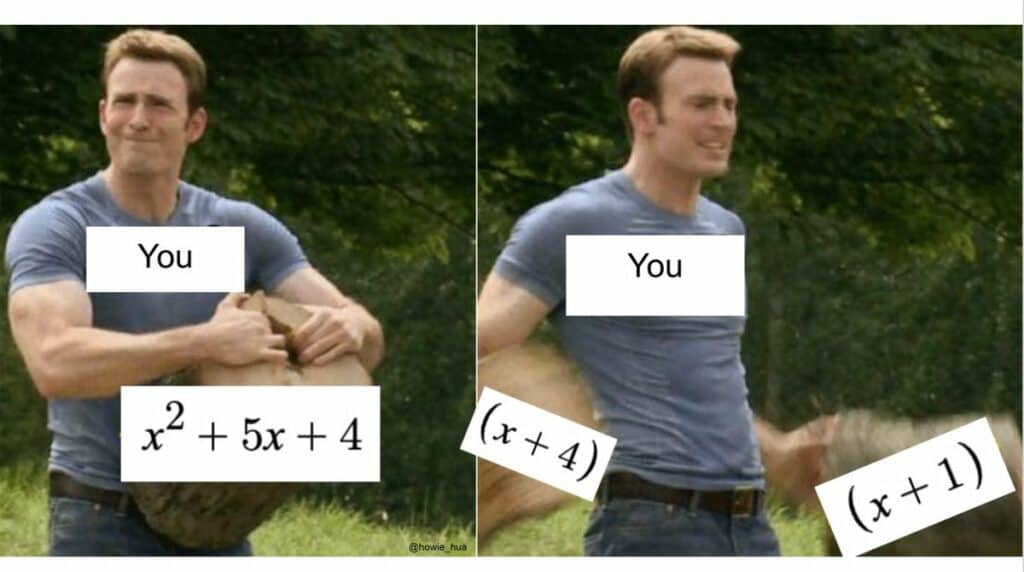
Factoring expressions is one of those tasks in algebra that often feel tedious and pointless. This is even more true once someone points out that the vast majority of polynomials we could create aren’t factorable at all. But not all possible polynomials occur in the real world with the same frequency. Because of the nature of real-world applications, polynomials (such as revenue = price * quantity) are often generated by multiplication in the first place. Thus, there is still value in learning to factor polynomials and other expressions, breaking them apart into their component factors.
Primarily, factoring an expression allows us to look at the expression in an equivalent but different format, where we can observe different characteristics of the function the expression represents and perform different operations on the expression.
By factoring, or unmultiplying, we break an expression into its component factors. This allows us to see the factor “building blocks” making up that expression. These factors sometimes allow us to simplify expressions, multiply and divide expressions more easily, find least common denominators when we need to add and subtract, find the roots or zeros (which, as this article points out, helps in error analysis and error minimization), and explore properties and patterns in numbers more deeply.
Find the multiplicative “building blocks”
In applied practice many polynomials are built from, or represent, the product of two other polynomials. The example I listed above is that Revenue = Price * Number Sold. Similarly, Total Cost = Cost Per Unit * Number of Units. Thus, if we’re given a revenue or total cost function, it can be useful to be able to factor this function into its component parts (price and number sold, or cost per unit and number of units, respectively). This helps us investigate more deeply and precisely how to minimize losses or maximize profits, for example, and ultimately saves us time compared to troubleshooting via trial and error.
Simplify the expressions
Sometimes, factoring allows us to simplify expressions, or write them in a form that is easier to use or interpret in some way. This is especially true when the expression is a rational expression (a polynomial divided by a polynomial). This process is exactly the same as simplifying numeric fractions, with one notable difference (discussed in the next paragraph). This not only saves writing in future steps of the problem, but also, the cancelled and uncancelled expressions will have the same graph shape and the same general behavior. It just might be simpler to graph and/or describe that behavior from the simplified form.
Finding missing data and asymptotic behavior
Whereas a fraction with a common factor in the numerator and denominator is exactly equal after cancelling the common factor, a rational expression involving variables has a very subtle difference between its cancelled and uncancelled form. If you were to graph a rational function both before and after cancelling, the two graphs would look almost identical. However, the uncancelled function would have a “hole,” or missing point, in the graph at the $x$-value that makes the cancelled factor equal to zero! Simplifying these expressions can tell us about locations where the function is not defined. Sometimes the behavior of the function is this single missing data point. Sometimes the behavior is asymptotic, or running off forever and ultimately quite rapidly in a certain direction as you approach a certain input value. The process of factoring and simplifying can help us identify both of these situations (and hopefully prevent any real-world problems this type of behavior might bring about!)
Easier multiplication and division
The factored form of an expression makes its factors explicit. It is written as a series of multiplications. Thus, extending it to further multiplication allows us to use all of the properties of multiplication (primarily associative and commutative) to collect common factors and list them in an order that makes it either most aesthetically pleasing or easiest to use and/or interpret. Further, since division is so closely related to both multiplication and fraction work, factoring allows us to use common factors to simplify the process of division as well.
Least Common Denominators: Adding and Subtracting
When we need to add rational expressions, factored denominators make it possible to find the least common denominators rather than just any random denominator. When we’re talking about higher-degreed polynomials, this can be a significant savings of polynomial arithmetic and minimize computational errors. It can also help save the need to find common denominators in the numerator and denominator at the end of the process.
Finding roots and zeros
In applications, it’s often important to know when the output will be zero. For example, how many units you need to sell to break even (profit to be equal 0, with no financial gain but also no financial loss). These are called the zeros of that function. We sometimes also use the word root to refer to the solutions of an equation where one side is zero. (In practice, these are essentially the same idea, just a difference in language based on subtle context differences.) Factoring allows us to find these zeros, or roots, without much trial-and-error, reducing the time we need to explore these important quantities.
Explore properties and patterns in numbers
Have you ever looked at the sequence of perfect squares? Check them out all in a row, and see what you notice: 1, 4, 9, 16, 25, 36, 49, 64, 81, 100, … .
Here’s a hint: What are the differences between each term? If I hadn’t told you this was a pattern of perfect squares, is there a different pattern you might notice?
If I look at the differences, I see $4-1=3$, $9-4=5$, $16-9=7$, $25-16=9$ — each difference between two terms seems to be the next odd number: 3, 5, 7, 9, 11, 13… . Algebra can help us see that this continues:
Let’s look at $11^2$ and $12^2$. $11^2=11*11=121$. Turns out, if I add twice 11 plus one, $2*11+1=23$, I get $12^2=121+23+144$. In fact, this holds true for all positive integers since $x^2+(2x+1)=x^2+2x+1=(x+1)(x+1)=(x+1)^2$, or, in other words, a perfect square plus twice the root plus one makes the next perfect square!
One use of algebra is to examine these types of patterns, to be able to prove that they are true for all numbers not just the few that we look at. Ultimately, mathematical patterns are not only just interesting, but they inform us about other patterns throughout our world as well. For example, this pattern tells us how the area of a square grows if we increase each side of the square by one unit. This has applications in landscape design, in engineering, in product development, in art, and in a myriad other contexts.
If this has inspired you to learn more about how to factor expressions, check out the factoring playlist at my YouTube channel. And remember…
You’ve Got This!
